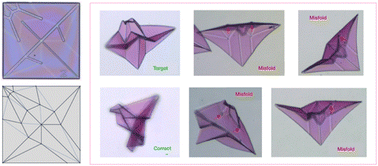Robust folding of elastic origami†
Abstract
Self-folding origami, structures that are engineered flat to fold into targeted, three-dimensional shapes, have many potential engineering applications. Though significant effort in recent years has been devoted to designing fold patterns that can achieve a variety of target shapes, recent work has also made clear that many origami structures exhibit multiple folding pathways, with a proliferation of geometric folding pathways as the origami structure becomes complex. The competition between these pathways can lead to structures that are programmed for one shape, yet fold incorrectly. To disentangle the features that lead to misfolding, we introduce a model of self-folding origami that accounts for the finite stretching rigidity of the origami faces and allows the computation of energy landscapes that lead to misfolding. We find that, in addition to the geometrical features of the origami, the finite elasticity of the nearly-flat origami configurations regulates the proliferation of potential misfolded states through a series of saddle-node bifurcations. We apply our model to one of the most common origami motifs, the symmetric “bird's foot,” a single vertex with four folds. We show that though even a small error in programmed fold angles induces metastability in rigid origami, elasticity allows one to tune resilience to misfolding. In a more complex design, the “Randlett flapping bird,” which has thousands of potential competing states, we further show that the number of actual observed minima is strongly determined by the structure's elasticity. In general, we show that elastic origami with both stiffer folds and less bendable faces self-folds better.



 Please wait while we load your content...
Please wait while we load your content...
